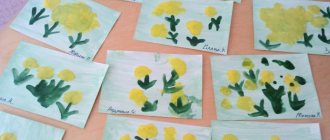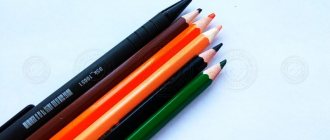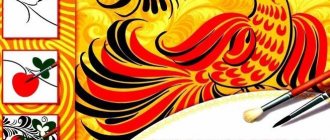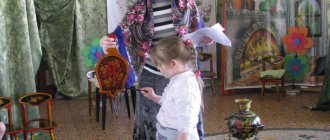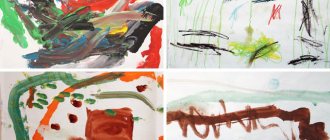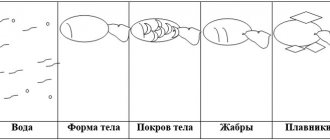Preparation for a drawing lesson on the topic “Girl in a smart dress” in the senior group
When preparing a lesson on drawing a girl in an elegant dress, the teacher faces a number of tasks:
- to develop children’s ability to draw a human figure, convey the shape of a dress, the shape and location of body parts;
- consolidate the techniques of drawing and shading a picture with a pencil;
- develop children's creative abilities - developing a dress pattern (design, shape, and decorations), completing the drawing of accessories, background, etc.
- develop the ability to evaluate your own drawings and the drawings of other children.
The lesson can be aimed either at children’s independent depiction of a girl in a dress, taking into account the proportions, or it can be carried out as part of decorative drawing, when students are offered ready-made dress templates for finishing and decorating.
Children 5–6 years old depict the human body initially as a set of geometric shapes:
- head - circle,
- neck - a small rectangle,
- body - rectangle or oval,
- legs and arms - in wide lines,
- fingers - thin lines, strokes.
Children's first drawings of people are geometric sketches
Six-year-olds are confident in their use of drawing tools. They manage to complete the task according to the sample presented. The choice of materials remains with the teacher: for the lesson it is necessary to prepare the basis for drawing and tools.
Drawing the figure of a girl in the older group is complicated by the introduction of new elements: costume, hairstyle, accessories
Drawing materials
To depict a girl in a dress, you will need the following materials:
- Lead pencils.
Important. Older preschoolers learn preliminary sketching. Children use a simple pencil to draw the outline of a person, a portrait, then paint with colored shading or strokes of paint.
- Paints: gouache,
- watercolor.
- medium thickness,
On a note. For painting with gouache, you can prepare colored cardboard or paper tinted with watercolors.
For drawing a girl in a dress, colored pencils and gouache are best suited.
The design of patterns and details of the dress can be done using non-classical materials. Paints with glitter, mother-of-pearl effect, bright markers, and gel pens are used. They should be distributed to children at the end of the practical work, when the drawing is ready and all that remains is to add additions to the character’s outfit.
Drawing techniques and techniques
In the senior group, children master and improve the following drawing techniques and techniques:
- Sketch. The teacher shows the stages of drawing on the board or explains the drawing diagram on a poster/sample. Preschoolers successively draw the details of the sketch in the air with a pencil and transfer them to paper.
A simple diagram demonstrating how to draw a human figure should be in front of your eyes during class
- Drawing with colored pencils. The skill of coloring figures inside contours is consolidated and mastery of basic techniques is improved: shading with weak and strong pressure;
- outlining and detailing with intense pressure.
Shading with pencils takes longer than drawing with paints, so give children 1/2 of a landscape sheet as a base.
- Fill the background only with watercolors and a wide brush.
Paintings are bright and festive
Video: how to draw a girl
The video can be viewed at the beginning of the lesson and used as a step-by-step plan for drawing a girl. Please note that it is recommended to draw the human figure from top to bottom, that is, starting from the head.
Video: how to draw a little fairy in an elegant dress
Fairies are also girls, and their dresses are more than elegant! An unusual character will attract guys. The video tutorial is aimed at small artists. The only thing is that drawing a cloak using the proposed method (around the fairy figure) may cause difficulties for children 5–6 years old. We advise you to limit yourself to a dress and head decoration.
The “Girl in a Dress” activity is suitable for introducing children to non-traditional drawing techniques (or improving unusual techniques). Children's works produce original and even fantastic outfits. Many methods are suitable for depicting a dress or amazing patterns on it:
- wax crayons,
- finger paints,
- cotton swabs,
- stamps,
- by poking method,
- spray.
Photo gallery: examples of drawings made using non-traditional techniques
Using stencils and wax crayons, an even ornament is transferred to the dress
Use fingers and cotton swabs to draw various geometric patterns: dots, stripes, checkered patterns
Watercolor droplets swell on paper in intricate patterns
The dress can be decorated with finger paints to create a polka dot pattern
Beautiful patterns spread out on a damp sheet of paper, like in the batik technique
Original dresses can be made from children's handprints
Combination with other types of visual activities
Drawings on the theme “Girl in a smart dress” are organically complemented by plasticine elements and paper applique:
- as background objects (trees, flowers, clearing, house);
- as a decoration in a girl’s outfit (patterns, frills and ribbons on clothes, a headdress, hairpins).
Origami and plasticineography methods can be used to create a dress, and the girl herself can be drawn using classical techniques.
Folding a dress using the origami technique is a full-fledged task, not just an addition
An elegant dress for a girl can be made with appliqué from natural/waste material:
- scraps of fabric,
- dried flowers and leaves,
- flat multi-colored buttons,
- sequins, rhinestones
The dress can be made in the form of an applique of leaves or other natural materials
How to personalize tasks
An individual-personal approach to fine art classes is implemented by providing children with independence in creativity and adapting the requirements for some students.
Ways to differentiate tasks:
- Give the opportunity to choose a color palette for drawing.
- Determine the purpose of the lesson (draw a girl in an elegant dress) and show embodiment options: a baby in a sundress, a princess getting ready for a ball.
- Prepare a simplified task. For example, trace a girl’s stencil and draw an outfit yourself.
- For creatively gifted children, complicate the task: draw a background object, accessories for a girl, etc.
Creatively gifted children aged 5–6 years create their first narrative drawings
Place of the lesson “Girl in an elegant dress” in the card index of drawing topics
Drawing a girl in a dress is a broad topic. In this version, it is heard during a lesson on practicing the technique of mixing colors and shades: children select a palette for the character’s skin, hair, and clothes.
In narrow interpretations, the theme is repeated and developed throughout the school year:
- “The doll is going to visit” - learning the rules of etiquette.
- “When Mom was little” - making a postcard for March 8th.
- “Cinderella at the Ball” is a repetition of the fairy tale about Cinderella.
- “Girl in a folk dress” is an introduction to national life and costume.
Transforming Cinderella's clothes from rags into a ball gown - one of the options for the drawing “Girl in a beautiful dress”
A collective composition on a topic is compiled on a common basis - a tinted sheet of whatman paper. Children's drawings are placed in accordance with the plan.
Examples of group work:
- "Festive round dance"
- "Masha doll's birthday"
- "Doll Tea Party"
- "Our girls and boys at the matinee"
- "Princesses at the Ball."
Children can cut out their drawings along the contour to attach them to a common sheet of whatman paper
Progress of the lesson.
1.Teacher: - Hello, guys. Let's try to determine for ourselves what we will do today. Girls , we go to the middle of the group and line up.
Boys, look at our girls , tell me what they are wearing?
— The girls put on a dress , skirt, T-shirt, blouse, tights
- What shape and color is their dress , skirt, T-shirt? Who exactly wore the dress ? What is it like (Children's answers)
Educator: - Well, guys, tell me, what are we going to talk about today?
- Let's talk about dresses
2.Teacher: - I have prepared a dress . What is it like? (Children's answers)
Educator: - Tell me, what is missing from this template? (Children's answers)
- That's right, this template is missing a head, arms and legs. I will give you album sheets with ready-made dress , you will complete the head, arms and legs with colored pencils.
3. Didactic game “Which dress belongs to whom ?”
. The game takes place on the palace. Children sit in a circle.
Task. Form a dictionary. Learn to distinguish and name details and parts of objects.


